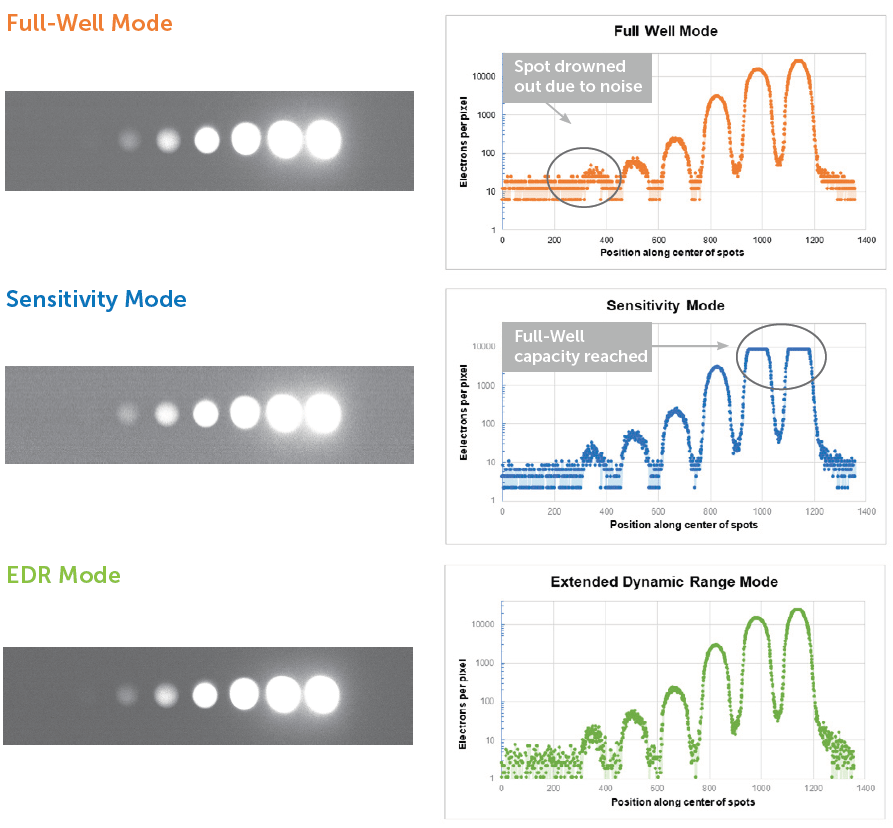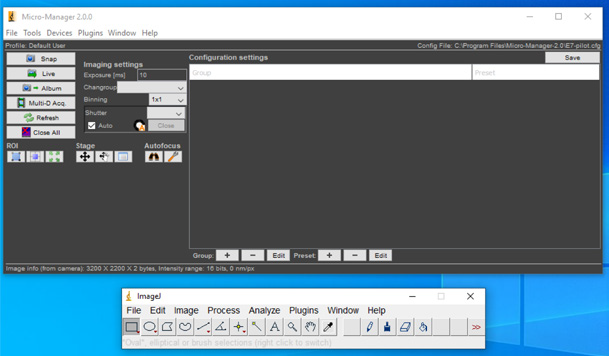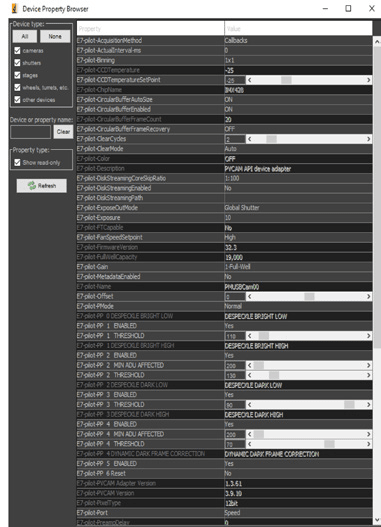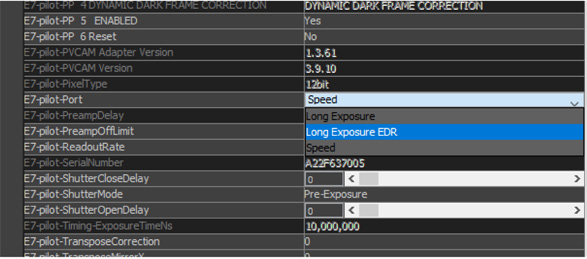Extended Dynamic Range
Introduction
The Retiga E7 CMOS camera features three different readout modes: Speed, Long Exposure, and the all-new Extended Dynamic Range (EDR). While Speed is a classic CMOS mode that features imaging across a large sensor at high speeds, Long Exposure and EDR feature an ultra-low dark current of 0.001 e-/p/s and allow for exposures of up to an hour, bringing CMOS into the long exposure regime, previously only occupied by CCD cameras.
However, when exposing the camera for such a long time, signal intensities can become very large and require a high dynamic range in order to display intense and weak signals together. When using Long Exposure mode, users pick between two gain states, one optimized for a large full well (gain 1, named Full Well), and the other optimized for lower read noise and therefore higher sensitivity (gain 2, named Sensitivity). But what if there was a mode that could do long exposures and could combine the benefits of both gain states? This is the reasoning behind EDR mode, which brings the best of both worlds.

Dynamic Range
Dynamic range refers to the ability of a camera to quantitatively detect both very dim and very bright parts of an image. For the Retiga E7 CMOS camera, the dynamic range is limited at the upper limit by the pixel full well capacity (around 23,000 electrons) and at the lower limit by underlying read noise (around 2 electrons), which can obscure fainter signals. The dynamic range can be calculated by taking the full well capacity and dividing it by the read noise; this value represents the maximum number of grayscale steps that the detected signal can be divided into.

By increasing the dynamic range, typically through greater full well capacity or lower read noise, a camera can detect finer changes in a sample, particularly when there are intense and weak signals present. In EDR mode, we can more than double the dynamic range, which produces excellent image quality and is recommended for static sample imaging applications which may involve varying light intensities in a single image.
Extended Dynamic Range Mode
The Retiga E7 CMOS camera offers two standard 12-bit gain states: Sensitivity and Full-Well. Sensitivity mode offers a lower read noise, allowing for very faint signals to be imaged without being lost in the noise. Full-Well mode, however, increases the capacity of each pixel's full well, which in turn allows for a higher "cut-off" saturation point.
Extended Dynamic Range mode combines these two 12-bit gain states to produce one 16-bit image. This is achieved by taking two consecutive images (one in Sensitivity mode and one in Full-Well mode) and converting them from their ADU values to photoelectrons by multiplying by their respective gain values. Then, each pixel is compared to a set threshold to decide which of the two stored photoelectron values should be used for that particular pixel - the Sensitivity mode value or the Full-Well mode value.
Each pixel - now containing a more desirable intensity level - reconstructs the final EDR image, capturing the fainter and stronger signals present in your sample. Producing an EDR image requires the acquisition of two separate images, each taken with the user-set exposure time, t. Thus, it will take double the user-set exposure time (2t) to acquire, process, and display an EDR image.
Full-Well vs Sensitivity vs EDR
Here we present three images of a Harta plate, which includes sequentially brighter spots and is therefore a good test of the dynamic range of a camera, which would need to display intense signals alongside weaker ones. We acquired long-exposure images of a Harta plate in Full-Well gain state, Sensitivity gain state, and EDR mode, acquired images and intensity plots displayed in Figure 1.
In Full-Well mode, six spots are visually detectable from the Harta plate without pixel saturation occurring, thanks to the large full-well. However, the sixth and dimmest spot's signal is buried in noise, as seen from the intensity plot. Being visible on an image isn't sufficient when needing to perform quantitative image analysis, and better noise characteristics are needed to analyse weaker signals.
In Sensitivity mode, although we get clear elevated signals for the dimmer spots, saturation is reached quite early, and we lose information from the two brightest spots. While sensitivity has improved performance with weaker spots due to lower read noise, the lower full well capacity means more intense signals saturate the pixels and level off the signal.
Extended Dynamic Range mode resolves both issues by combining the "best of both worlds" - Sensitivity mode's ability to pick up faint signals and Full Well mode's large full well capacity. The result is a 16-bit image in which the brightest signals aren't cut off prematurely, yet the dimmest signals are clearly defined.

Figure 1: Comparing the dynamic range of three imaging modes of the Retiga E7 CMOS camera. On the left are images of Harta plates with increasing signal, and on the right are intensity plots of each spot as they grow in intensity.
How To Enable EDR In MicroManager
Now that we've demonstrated the power of EDR mode in Fig.1, we can show you how to make use of this mode in your imaging with the Retiga E7 CMOS camera.

Firstly, open MicroManager

Then go to Devices and Device Property Browser

In Device Property Browser, go to E7-Port and set it to Long Exposure EDR
Summary
The Retiga E7 CMOS camera has a new mode: Extended Dynamic Range or EDR. This mode allows users to acquire long exposure images and take advantage of both a low read noise and a high full well capacity, by taking images with two different 12-bit gain states and producing a combined 16-bit EDR image. EDR mode is ideal when working with samples that feature both intense and weak signals together, and allow for much more accurate quantitative image analysis of even the most demanding samples.
Further Reading
Back To Exclusive Features
Book A Demo Today